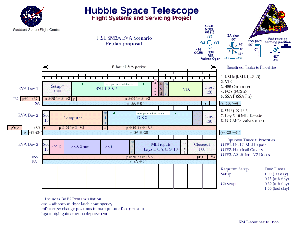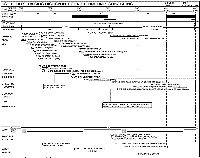|
Hubble
Extravehicular Activities (EVA) Timeline
As
a result of the weather-delayed launch, the mission has been
shortened to 3 EVA days. This will guarantee that the Discovery
will be safe from all possible Y2K problems under all contingency
return situations.
NASA calls a spacewalk an "Extra-Vehicular Activity",
or EVA. Each of the EVA servicing
periods is an EVA Day, although these "days" span two "Flight
Days". For example, EVA Day 1 begins two days and 19 hours
into the mission, and it ends in the second hour of the third
mission day. The tasks are arranged in order of importance
and efficiency. The spacewalkers will work in teams of two,
with each pair going out on alternating days.

December 18, 1999 Proposed EVA plan
Original
EVA Plan
EVA
Day 1
The first team will replace Hubble's three Rate Sensor Units
(RSUs), each containing two
gyros. They will also install Voltage/Temperature Improvement
Kits (VIKs) on Hubble's six
batteries.
2 Days, 18 Hours, 45 Minutes
EVA Day 1 Movie
 (11,400
KB)
(11,400
KB)  (77 KB)
(77 KB)
EVA
Day 2
The second team will replace the telescope's central computer
and a Fine Guidance Sensor (FGS).
3 Days, 19 Hours
EVA Day 2 Movie
 (11,800 KB)
(11,800 KB)  (85KB)
(85KB)
EVA
Day 3
The first pair of spacewalkers goes out again to replace a
transmitter and a data recorder, upgrade electronics, and
begin reinforcing Hubble's thermal skin.
4 Days, 19 Hours
EVA
Day 4
The second team returns to Hubble to finish attaching the
new thermal protection.
5 Days, 19 Hours
EVA Day 4 Movie
 (11,300 KB)
(11,300 KB) (178 KB)
(178 KB)
HST
Command Plan
The
Servicing Mission Command Plan is the set of procedures used
by Hubble's ground control team to prepare the telescope for
servicing, test the newly installed equipment, and release
the telescope back into orbit.
Shortly
after launch, the Space Telescope Operations Control Center
(STOCC) team will begin
transitioning the telescope from normal science operations
to a "ready for servicing" condition. They will command Hubble
to its capture attitude and configure it for rendezvous with
Discovery.
In
preparation for capture and berthing, the STOCC will instruct
Hubble's aperture door to close and the high gain antennas
to be stowed. Immediately after the astronauts install the
new equipment, they will move to a safe location. Then, the
STOCC will test the hardware to determine if more work is
needed. Later, while the crew sleeps, the STOCC team will
perform more detailed checkouts. Finally, at the mission's
end, ground controllers will prepare Hubble for its return
to normal operations.
Servicing
Mission Integrated Timeline
The
Servicing Mission Integrated Timeline (SMIT)
The
Servicing Mission Integrated Timeline (SMIT) is a detailed,
minute-by-minute schedule of mission activities. It simultaneously
shows all major work performed by the astronauts and the ground
controllers. The timeline also includes several time measures
(mission elapsed time, orbit number, UT, etc.), the position
of the Shuttle and Hubble, and the astronauts' sleep time.
The servicing team relies on this script-like schedule to
track mission progress.
 |
|
Sample
SMIT page
|
How
to Read the Integrated Timeline
TIME:
The clock begins at launch. The time is shown in Greenwich
Mean Time (GMT) and Mission Elapsed Time (MET).
- For
GMT, the day of the year is shown in the margin.
- For
MET, the day of mission is shown in the margin.
ORBIT#: When the Shuttle begins preparations for rendezvous
with Hubble, the ORBIT# will be that of the Shuttle. Prior
to these preparations, the ORBIT# will be that of Hubble.
DAY/NIGHT:
The shaded areas show when Hubble is in the Earth's shadow.
The light areas represent Hubble's daytime.
SAA:
Time in the South Atlantic Anomaly. The SAA is an area of
intense radiation above the coast of Argentina. As the Shuttle
and other satellites pass through it, the SAA can disrupt
electronics and communications signals. It is the southern
point of the Van Allen Belt.
HST
ATTITUDE: How Hubble is positioned.
ORBITER
ATTITUDE: How the Shuttle is positioned.
CREW
SCHEDULE: Major crew activities, such as preparing for
a spacewalk and sleeping.
ORBITER,
CREW, SSE: The Shuttle and astronaut activities relating
to Hubble and the Space Support Equipment (SSE).
FUNCTIONAL
COMMAND: A description of the command and verification
activities performed by Hubble's ground controllers. A legend
in the margin shows the different types of commands.
TLM
FORMAT: The telemetry format requirements for the engineering
and science channels.
TDRSS/I&C:
The area of communication coverage and the Zone Of Exclusion
(ZOE).
GROUND
SYSTEM ACTIVITIES: The major activities within the Space
Telescope Operations Control Center (STOCC).
MAJOR
EVENTS: An overview of all major activities in space and
on the ground.
Back
to Top
|